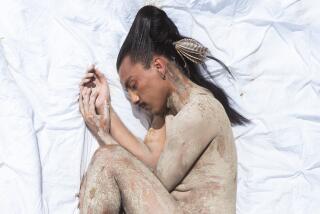Doing Deja’s Hair
- Share via
“My mama say my hair nappy,” Deja declared that first night as I tucked her into bed with a brand-new doll.
I had been collecting kids’ clothes and toys since being certified as a foster parent a month earlier. There were myriad reasons behind my decision to become one: I wanted to change my own life as well as the lives of kids who are victims of abuse, neglect, homelessness and prenatal drug exposure. I wasn’t planning to adopt children, just foster them until they could be reunified with family or find a permanent home with someone else.
Then I met Deja, a 2-year-old recently abandoned by her birth mother. Deja was delivered to my house in the back seat of a Berkeley police car less than an hour after a placement worker at the foster care agency called to ask if I could take her. I’d expected a tearful, frightened little girl, but Deja was inquisitive, engaging and in astoundingly good health--both physically and emotionally. She crawled inside my heart within minutes. It wasn’t long before I began thinking about adopting her.
I knew it was the right thing for me to do, though I’m white and she’s black. Except that I hadn’t a clue how to care for her hair, something that wasn’t addressed in my 30 hours of foster parent training classes. Over time I would come to understand how well-styled hair can play an essential role in the cultural identity of African American girls, and how being a transracial family increased our visibility in public places. Not all the glances in our direction would be approving, and the additional scrutiny suggested to me that my daughter had better look properly groomed.
My first lesson: Deja’s hair was probably “nappy” when she arrived six years ago because it had been a while since it was properly combed and cared for. Someone had started putting extension braids in it but never finished the job, and the hair that wasn’t in braids coiled in and around itself like a bird’s nest.
So before the subject of her adoption was ever broached, my social worker put me in touch with an African hair braider, Yamata, who had learned how to braid in her native Nigeria. In her East Oakland apartment, Yamata went at Deja’s hair with oils, combs and vigor, until the ratty-looking extensions were gone and my new foster daughter’s hair was shiny and smooth, her whole head sprouting numerous springy little braids.
I watched as Yamata’s hands worked their magic. I watched as she wrapped tiny black rubber bands around the newly parted hair.
Then, as the mountain of adoption-related paperwork was being processed and I tried not to worry about delays and setbacks, I worked on Deja’s hair, she sitting on beds, chairs and sometimes in the tub, me behind her, our skin contrasting like night and day. I rubbed countless hair products into her short, coarse hair. I worked it into a thousand different styles using barrettes, beads, rubber bands and what the kids call “knockers”--those elastic bands with colored balls at either end.
“Keep practicing, Annie,” an African American teacher told me in a kind but slightly patronizing tone the first time I attempted cornrows and proudly presented Deja at her preschool. Cornrows, with their African origins and infinite style variations, appealed to me aesthetically, but my fledgling attempt yielded cornrows that were far from snug and tight or uniform in size.
I did keep practicing. At first my hands felt like pretzels, more twisted than the hair I was purporting to braid. The idea of cornrows is to make neat parts, usually from the forehead to the nape of the neck, and take three small portions of each parted section. You then work your way along by continually adding hair from the larger section to each of the three strands.
Somehow, even as I watched other people execute proper cornrows, I ended up devising my own technique, in which I only added hair to every other portion.
Once, when Deja was 5, an African American woman with a weave watched me “neaten” Deja’s hair during a break at a meeting of potential foster parents where I had been invited to speak.
“What are you doing, tying it in knots?” she asked with a knowing smile. I gave my kindergartner’s hair over to this stranger’s hands; she pulled a wide-toothed comb out of an oversized satin purse and told me, “You should always carry a big comb with you.”
I watched as her hands raced along Deja’s scalp in a blur, and after our break was over and I’d finished my spiel, my little girl said, “Why can’t you do my hair that good, Mom?”
“I’m working on it, sweetie,” I told her.
Deja, whose adoption was finalized four years ago, is 8 now, and I am still working on it. Maybe by the time I figure out how to do dazzlingly neat cornrows, and get truly comfortable in the aisles of ethnic hair sections in drugstores or at beauty supply outlets, my beautiful daughter will prefer to visit hair salons instead of enduring my well-intentioned attempts.
Not long ago I offhandedly remarked that a doll’s hair looked nappy.
“What’s ‘nappy’ mean?” my daughter asked--her memory of the word evidently as forgotten as recollections of the woman who used to be her mama.
“It means small, tight curls,” I answered. “It means beautiful.”






